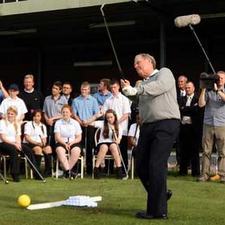When Jack Nicklaus came to Colorado in August to watch son Gary compete in the U.S. Amateur, he held court with reporters at CommonGround Golf Course for 15 minutes.
The topics Nicklaus addressed covered the spectrum, as they often do at public appearances for arguably the greatest player the game has ever known. But the subject that clearly piqued Nicklaus’ interest the most was a big-picture item that has been at the top of the agenda for golf administrators and others who care greatly about the sport: growing the game of golf in the future.
The winner of 18 major championships — plus two U.S. Amateurs — spent 2 1/2 minutes addressing a single question about the topic. Amid the hoopla of the U.S. Amateur that week, Nicklaus’ thoughts on the subject received little attention at the time, but they’re worth revisiting.
The issue has taken on a much higher priority given how golf participation has dropped somewhat in recent years. The National Golf Foundation reports that the number of golfers in the U.S. decreased from 30 million in 2005 to 25.7 million in 2011 after consistently rising for decades.
“It’s about time we not be so stodgy, saying the game is OK,” Nicklaus said during his August visit to Colorado. “Well, it’s not OK. It’s like everything else — you’ve got to work at it if you want to be successful.”
Some of Nicklaus’ thoughts on what’s going on with golf — and how to potentially address the issues — aren’t novel, but it’s obvious he has taken time to think about the subject in more than a cursory manner.
Perhaps part of that is due to something Nicklaus pointed out earlier in the interview session at CommonGround: none of his grandchildren plays much golf; they all play other sports. And these are grandkids of the man most people consider the top golfer of all time.
The NGF notes that the number of junior golfers in the U.S. has dropped dramatically — from 3.8 million in 2005 to 2.4 million in 2011. And female golfers have decreased from 7 million in 2005 to 5.1 million in 2011.
“Another statistic that blows my mind is, if you don’t start golf by the age of 8 — if you start after that — 89 percent of them leave the game,” Nicklaus noted. “I think that’s because … the team sports that are played in the park systems. Starting at 4-5 years old, kids are playing football, basketball, soccer, baseball. They’re playing all these sports, and by the time a kid is 8 years old, he’s picked two or three sports.
“It didn’t used to be that way. I played all sports, but we didn’t have anything organized until we were maybe 11 or 12 years old. But today they do. So I think it’s become abundantly clear that golf needs to get (more) into the park systems.”
Nicklaus suggests that kids start with clubs and balls with which no one is going to get hurt, then having artificial, movable greens that can be used on athletic fields when they’re vacant.
“You need to get (it) into a team sport and get kids together and draft them like all the other sports do,” he said. “I think the kids are going to have a blast (with that). And what it will mean is a bunch of kids will take up the game of golf. It’s not that they’re playing ‘golf’ golf, but when you’re playing flag football you’re not playing ‘football’ football; when you’re playing basketball with a 6-foot hoop you’re not playing basketball; when you’re playing T-ball you’re not playing baseball. But you graduate into those sports. We need a way to graduate.
“Tennis has done a wonderful job with playing the half courts and the little nets and bringing the young kids in. Golf needs to do those same things. They need to think out of the box and they need ways to introduce the game to kids.
“Kids and women, when they play the game, they need to have some success. The game has always been too difficult. They need to have bigger holes and easier ways to play so that they can learn to play, so that they can say, ‘how do we graduate into the game? But we have fun what we’re doing now (in the meantime).'”
Nicklaus notes that the PGA of America, the USGA and The First Tee have developed many programs that are on the right track, but there’s plenty more work to be done. (In Colorado, the Colorado PGA Golf in Schools program — in which the CGA and CWGA are also major players — the “Get Golf Ready” campaign and several junior developmental programs the CGA and CWGA support address some of the issues Nicklaus mentioned.)
Nicklaus believes things will eventually turn around for golf, but not without diligently working on the problem and continually fostering new ideas.


